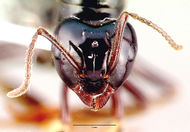Key to Lasius Dendrolasius queens of the East Palaearctic
This queen key is based on: Radchenko, A. 2005. A review of the ants of the genus Lasius Fabricius, 1804, subgenus Dendrolasius Ruzsky, 1912 (Hymenoptera: Formicidae) from East Palearctic. Annales Zoologici. 55(1):83-94.
Queens of Lasius capitatus are unknown.
Starcke (1942) described Lasius buccatus from Bosnia, based on the queens and male. I have never seen either the type specimens of this species, nor any other materials referred to it, and have no definitive opinion on the taxonomic status of this form. However, Wilson (1955) supposed L. buccatus to be a good species on the basis of several somewhat unusual characters of the queens, especially for their head narrower than the alitrunk. If Starcke's description and drawings were correct, this feature would be unique for Dendrolasius species. This question may be clarified after obtaining the type specimens and additional material from the type locality or any adjacent regions.
You may also be interested in
1
- Scape and legs, including the first tarsal joint, remarkably flattened, ratio of min/max diameters of scape and hind tibiae ≤ 0.4 (Figs 36, 37, 48-51) . . . . . 2
- Scape and legs not flattened, elliptical in cross-section, ratio of min/max diameters of scape > 0.6, same of hind tibia > 0.7 (Figs 11-14, 62-65, 76-79) . . . . . 3
2
return to couplet #1
- Body and appendages with very dense decumbent pubescence, alitrunk dorsum with relatively sparse, short standing hairs; petiolar scale (seen in profile) low, thick, not narrowing to the top, with widely rounded dorsum (Fig. 37). Head with emarginate occipital margin, but not cordiform and at most slightly wider than its length (Fig. 36) . . . . . Lasius orientalis
- Body (except the appendages) with very short and sparse decumbent pubescence, alitrunk dorsum without standing hairs; petiolar scale (seen in profile) quite high, narrowing to the top, with a very thin dorsal crest (Fig. 46). Head with strongly emarginate occipital margin, cordiform, distinctly wider than long (Fig. 45). . . . . . Lasius spathepus
3
return to couplet #1
- Body appears shiny, with very sparse short standing hairs, and with extremely short and sparse decumbent pubescence(Fig. 74) . . . . . Lasius morisitai
- Body appears dull, with numerous, long standing hairs; decumbent pubescence abundant or sparse (Figs 16, 60) . . . . . 4
4
return to couplet #3
- Head in full face view distinctly narrowing anteriorly, its lateral margins in front of the eyes almost straight; ·occipital margin very shallowly concave or almost straight; head outline with very abundant, long, often curved, protruding standing hairs (Fig. 15). Petiolar scale (seen in profile) thin, distinctly narrowing to the top, with a somewhat flattened dorsal crest (Fig. 16). Hind tibiae and scape with dense decumbent pubescence and numerous subdecumbent hairs (Figs 18-21) . . . . . Lasius nipponensis
- Head in full-face view weakly narrowed anteriorly, with regularly convex sides; occipital margin distinctly emarginate; head outline with less abundant, relatively short, straight standing hairs (Fig. 59). Petiolar scale (seen in profile) thick, at most slightly narrowing to the top, with a rounded dorsal crest (Fig. 60). Hind tibiae and scape with dense decumbent pubescence only (Figs 62-65) . . . . . Lasius fuji







